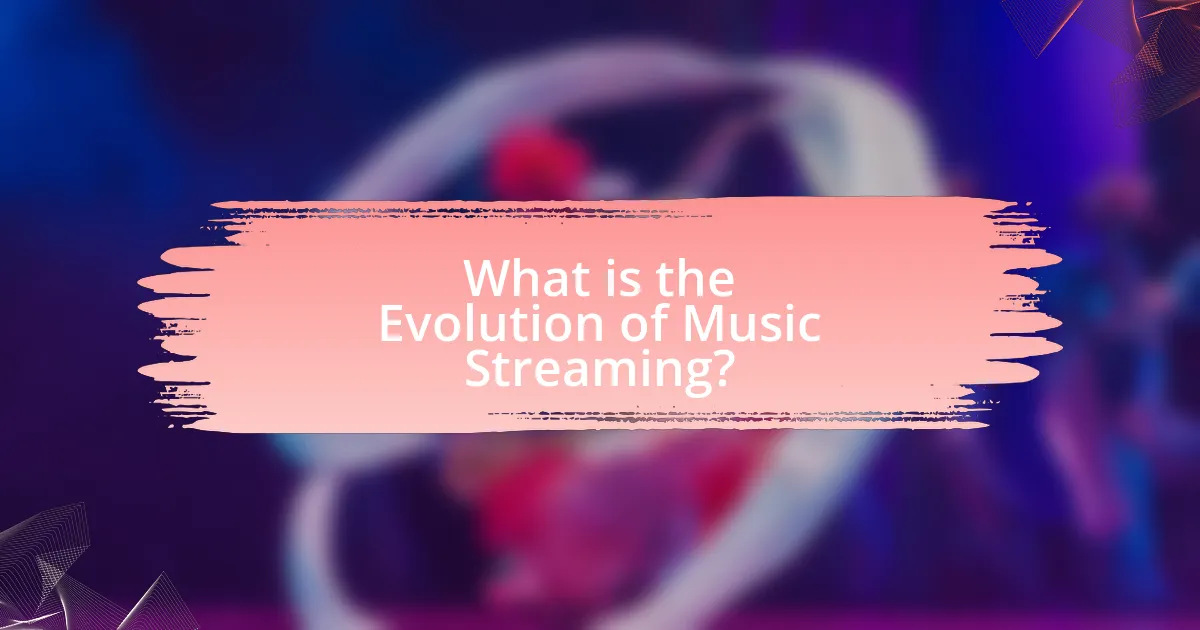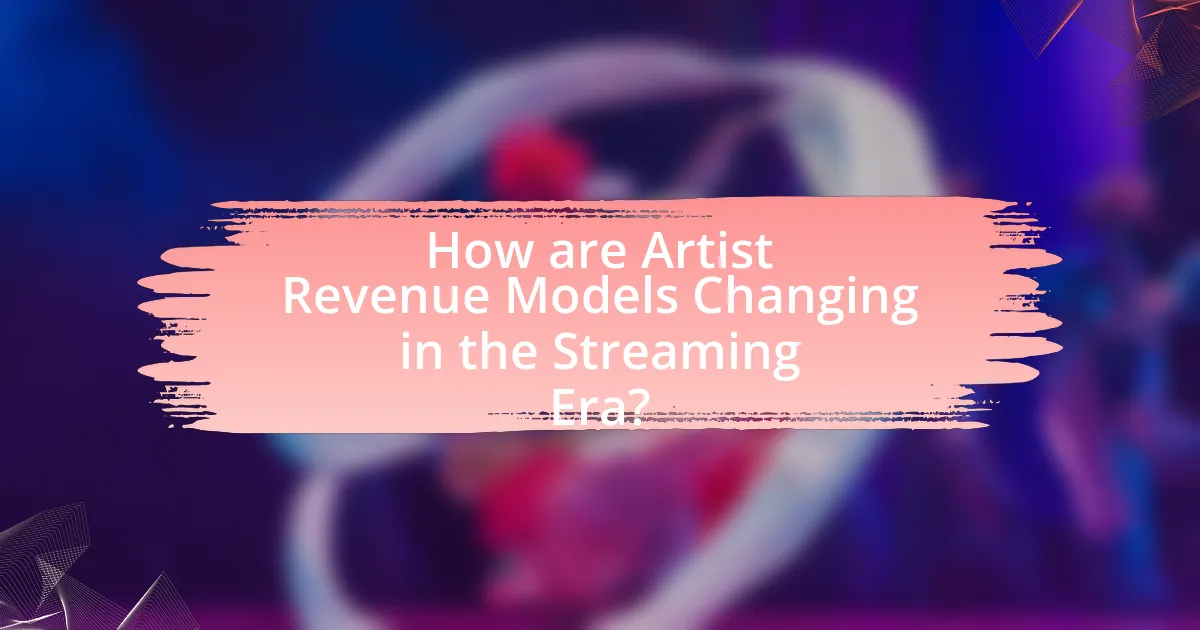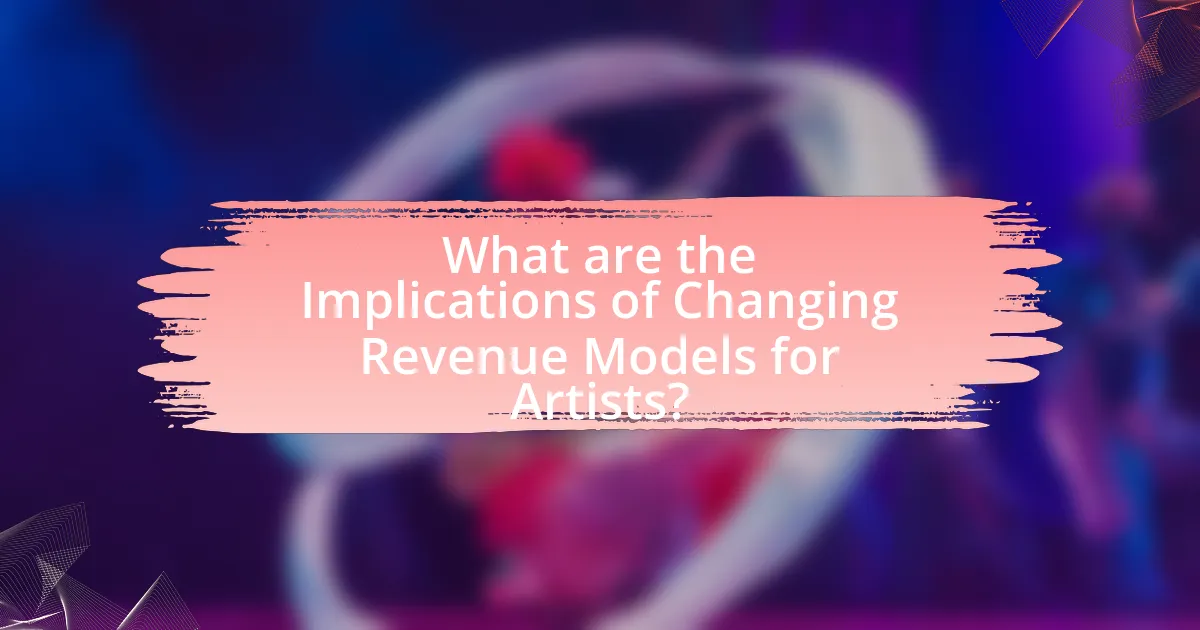The article examines the evolution of music streaming and its impact on artist revenue models. It traces the history of music streaming from the late 1990s, highlighting key milestones such as the rise of platforms like Napster, iTunes, Spotify, and Apple Music. The discussion includes how technological advancements and changing consumer behaviors have shifted the music industry towards streaming, which now accounts for over 80% of music revenue. Additionally, it explores the challenges artists face with lower per-stream payouts and the necessity for diversified income sources, including direct-to-fan sales and engagement strategies, as they adapt to the new landscape dominated by streaming services.

What is the Evolution of Music Streaming?
The evolution of music streaming began in the late 1990s with the introduction of platforms like MP3.com, which allowed users to upload and share music. This was followed by the emergence of services such as Napster in 1999, which revolutionized music sharing through peer-to-peer technology, leading to significant legal battles over copyright infringement. In the early 2000s, legal music download services like iTunes launched, allowing users to purchase individual tracks legally.
The transition to streaming began in earnest with the launch of services like Pandora in 2005, which offered personalized radio stations, and Spotify in 2008, which introduced a subscription model that allowed users to access vast libraries of music without purchasing individual songs. By 2015, streaming surpassed digital downloads in revenue, marking a significant shift in how music was consumed and monetized.
As of 2023, streaming services dominate the music industry, with platforms like Apple Music, Amazon Music, and YouTube Music contributing to a landscape where artists earn revenue primarily through streaming royalties rather than traditional album sales. This shift has prompted changes in artist revenue models, emphasizing the importance of streaming numbers and audience engagement over physical sales.
How has music streaming changed over the years?
Music streaming has evolved significantly over the years, transitioning from a niche service to a dominant force in the music industry. Initially, platforms like Napster and LimeWire popularized file sharing in the early 2000s, but legal challenges led to the rise of licensed services such as Spotify and Apple Music. By 2023, streaming accounted for over 80% of music industry revenue, reflecting a shift in consumer behavior towards on-demand access rather than ownership. This change has also impacted artist revenue models, with streaming services offering various payment structures, often resulting in lower per-stream payouts compared to traditional album sales.
What technological advancements have influenced music streaming?
Technological advancements that have influenced music streaming include the development of high-speed internet, cloud computing, and mobile technology. High-speed internet has enabled seamless streaming of high-quality audio, allowing users to access vast music libraries without interruptions. Cloud computing has facilitated the storage and distribution of music, enabling platforms to offer extensive catalogs and personalized recommendations. Mobile technology has made music streaming accessible on-the-go, significantly increasing user engagement and consumption. According to a report by the International Federation of the Phonographic Industry, global music streaming revenues grew by 19.9% in 2020, highlighting the impact of these technological advancements on the industry.
How have consumer behaviors shifted with music streaming?
Consumer behaviors have shifted significantly with music streaming, leading to increased accessibility and consumption patterns. The rise of platforms like Spotify and Apple Music has enabled users to access vast libraries of music on-demand, resulting in a decline in physical album sales and digital downloads. According to the Recording Industry Association of America (RIAA), streaming accounted for 83% of the U.S. music industry’s revenue in 2021, illustrating a clear preference for subscription-based models over traditional purchasing methods. Additionally, listeners now engage with music through curated playlists and algorithm-driven recommendations, which has changed how they discover and interact with new artists and genres. This shift reflects a broader trend towards convenience and personalization in consumer behavior within the music industry.
What are the key milestones in the history of music streaming?
The key milestones in the history of music streaming include the launch of MP3.com in 1997, which allowed users to upload and share music, marking the beginning of digital music distribution. In 2001, Apple introduced iTunes, which revolutionized music purchasing and paved the way for digital downloads. The emergence of Pandora in 2005 introduced personalized internet radio, while Spotify’s launch in 2008 popularized the subscription model for music streaming. In 2015, Apple Music entered the market, further solidifying streaming as the dominant method of music consumption. These milestones illustrate the rapid evolution of music streaming and its impact on artist revenue models, shifting from sales to subscription-based income.
Which platforms have played a significant role in this evolution?
Spotify, Apple Music, and YouTube have played significant roles in the evolution of music streaming. Spotify revolutionized the industry by introducing a freemium model that allows users to access a vast library of music for free with ads or through a subscription without ads, significantly impacting artist revenue models. Apple Music followed with a subscription-only model that emphasizes exclusive content and artist partnerships, further shaping how artists monetize their work. YouTube, as a video platform, has also been crucial by providing a space for artists to share their music and generate revenue through ad placements, thus influencing the overall landscape of music consumption and artist earnings.
How did the introduction of subscription models impact the industry?
The introduction of subscription models significantly transformed the music streaming industry by providing a steady revenue stream for artists and platforms. This shift allowed for predictable income, which is crucial for artists’ financial stability, as evidenced by the increase in streaming revenue from $1.5 billion in 2015 to over $10 billion in 2020, according to the Recording Industry Association of America (RIAA). Additionally, subscription models have led to a surge in user engagement, with platforms like Spotify reporting over 400 million active users, including 180 million subscribers, which enhances the visibility and reach of artists’ work.

How are Artist Revenue Models Changing in the Streaming Era?
Artist revenue models are changing in the streaming era primarily due to the shift from traditional sales to streaming-based income. In the past, artists relied heavily on physical album sales and live performances for revenue. However, with the rise of platforms like Spotify and Apple Music, streaming has become the dominant method for music consumption, leading to a significant decrease in per-album sales.
As a result, artists are increasingly focusing on building larger fan bases to generate income through streaming royalties, which are typically lower per play compared to album sales. For instance, in 2021, the average payout per stream was estimated to be between $0.003 and $0.005, compelling artists to seek alternative revenue streams such as merchandise sales, crowdfunding, and live performances. Additionally, many artists are leveraging social media and direct-to-fan platforms to enhance engagement and monetize their content more effectively.
This evolution reflects a broader trend where artists must adapt their strategies to thrive in a landscape dominated by streaming services, emphasizing the importance of fan engagement and diversified income sources.
What traditional revenue models did artists rely on before streaming?
Artists relied on several traditional revenue models before the advent of streaming, primarily including album sales, live performances, merchandise sales, and licensing. Album sales constituted a significant portion of an artist’s income, with physical formats like vinyl, cassette, and CDs generating revenue through retail distribution. Live performances served as another crucial revenue stream, with artists earning money from ticket sales and performance fees. Merchandise sales, including branded clothing and accessories, provided additional income, often sold at concerts or through online platforms. Licensing deals, where artists allowed their music to be used in films, commercials, or television shows, also contributed to their overall revenue. These models collectively formed the backbone of an artist’s financial ecosystem prior to the rise of streaming services.
How did album sales and live performances contribute to artist income?
Album sales and live performances significantly contribute to artist income by providing primary revenue streams. Historically, album sales have generated substantial earnings for artists, with physical sales peaking in the early 2000s, where top albums could sell millions of copies, translating to millions in revenue. For instance, in 2000, the best-selling album in the U.S. was ‘No Strings Attached’ by NSYNC, which sold over 9.4 million copies in its first week, showcasing the financial impact of album sales.
Live performances, on the other hand, have become increasingly vital, especially as streaming has diminished the profitability of recorded music. In 2019, live music revenue in the U.S. reached approximately $27 billion, with artists earning a significant portion from ticket sales, merchandise, and sponsorships during tours. For example, Taylor Swift’s ‘Reputation Stadium Tour’ grossed over $345 million, highlighting how live performances can surpass traditional album sales in generating income for artists. Thus, both album sales and live performances are crucial for sustaining artist income in the evolving music industry landscape.
What challenges did artists face with traditional revenue models?
Artists faced significant challenges with traditional revenue models, primarily due to reliance on physical sales and limited income streams. The decline of album sales, which dropped by 50% from 1999 to 2019, severely impacted artists’ earnings, as they often depended on CD sales for revenue. Additionally, traditional models offered minimal compensation for live performances and merchandise, which were not sufficient to sustain many artists financially. The dominance of record labels further restricted artists’ control over their work and revenue distribution, leading to unfavorable contracts that often left them with a small percentage of profits. These factors collectively contributed to a precarious financial situation for artists within the traditional music industry framework.
How do current streaming platforms compensate artists?
Current streaming platforms compensate artists primarily through a per-stream payout model, where artists earn a fraction of a cent for each stream of their music. For example, Spotify’s average payout ranges from $0.003 to $0.005 per stream, depending on various factors such as the listener’s location and subscription type. This model is based on a revenue-sharing system, where platforms distribute a portion of their subscription and advertising revenue to rights holders, including record labels, songwriters, and performers. As of 2023, it is estimated that streaming services collectively generated over $10 billion in revenue, significantly impacting how artists earn income compared to traditional sales methods.
What is the role of streaming royalties in artist revenue?
Streaming royalties play a crucial role in artist revenue by providing a significant source of income in the digital music landscape. As of 2023, streaming platforms like Spotify and Apple Music account for over 80% of recorded music revenue, highlighting the importance of these royalties for artists. Each time a song is streamed, artists receive a fraction of a cent, which accumulates over time, contributing to their overall earnings. This model has shifted the traditional revenue streams, such as physical sales and downloads, making streaming royalties essential for many artists’ financial sustainability.
How do different platforms compare in terms of artist payouts?
Different music streaming platforms exhibit significant variations in artist payouts. For instance, Spotify pays artists approximately $0.003 to $0.005 per stream, while Apple Music offers around $0.007 to $0.01 per stream. Tidal, known for its higher payout model, compensates artists about $0.0125 per stream. These differences arise from each platform’s revenue-sharing agreements and subscription models. According to a 2021 report by the Music Industry Research Association, platforms like Tidal and Apple Music prioritize artist compensation more than Spotify, which relies heavily on ad revenue. This data illustrates the ongoing debate about fair compensation in the evolving landscape of music streaming.

What are the Implications of Changing Revenue Models for Artists?
Changing revenue models for artists significantly impact their financial stability and creative freedom. As streaming platforms dominate the music industry, artists often receive lower per-stream payouts compared to traditional sales, which can lead to reduced income. For instance, a report from the Digital Media Association indicates that artists earn an average of $0.003 to $0.005 per stream, making it challenging for many to sustain a living solely from streaming revenue. Additionally, the shift towards subscription-based models encourages artists to engage directly with fans through merchandise and live performances, fostering a more personal connection but also requiring them to diversify their income sources. This evolution necessitates that artists adapt their business strategies to navigate the changing landscape effectively.
How are artists adapting to the new revenue landscape?
Artists are adapting to the new revenue landscape by diversifying their income streams beyond traditional album sales and live performances. Many musicians are increasingly leveraging digital platforms, such as streaming services, social media, and crowdfunding, to generate revenue. For instance, a report from the International Federation of the Phonographic Industry (IFPI) indicates that global recorded music revenues grew by 7.4% in 2020, largely driven by streaming, which accounted for 62.1% of total revenues. Additionally, artists are utilizing platforms like Patreon and Bandcamp to connect directly with fans, offering exclusive content and merchandise, which enhances their financial stability in a shifting market.
What strategies are artists using to maximize their income from streaming?
Artists are maximizing their income from streaming by diversifying revenue streams, engaging directly with fans, and leveraging data analytics. Diversification includes releasing music across multiple platforms, offering exclusive content, and creating merchandise tied to their music. Direct engagement with fans through social media and live streaming events fosters loyalty and encourages purchases. Additionally, artists utilize data analytics to understand listener preferences, optimize release strategies, and target marketing efforts effectively. For instance, a report by the International Federation of the Phonographic Industry (IFPI) highlights that artists who actively engage with their audience and analyze streaming data can increase their earnings significantly, demonstrating the effectiveness of these strategies.
How important is fan engagement in the streaming era?
Fan engagement is crucial in the streaming era as it directly influences an artist’s visibility and revenue. Engaged fans are more likely to stream music, attend concerts, and purchase merchandise, which are essential revenue streams for artists. According to a 2021 report by the International Federation of the Phonographic Industry, artists with higher fan engagement saw a 30% increase in streaming numbers compared to those with lower engagement levels. This demonstrates that active interaction with fans through social media, live performances, and exclusive content significantly enhances an artist’s financial success in the evolving music landscape.
What are the potential future trends in artist revenue models?
Potential future trends in artist revenue models include increased reliance on direct-to-fan sales, subscription-based services, and diversified income streams through NFTs and virtual performances. As artists seek to maximize their earnings, platforms like Bandcamp and Patreon are gaining traction, allowing musicians to sell merchandise and exclusive content directly to fans. Additionally, the rise of blockchain technology is enabling artists to monetize their work through NFTs, providing a new revenue avenue. According to a report by MIDiA Research, the global music subscription market is projected to grow significantly, indicating a shift towards models that prioritize recurring revenue over traditional sales.
How might blockchain technology impact artist compensation?
Blockchain technology may significantly enhance artist compensation by enabling direct transactions between artists and consumers, eliminating intermediaries. This direct interaction can lead to higher revenue shares for artists, as they can retain a larger portion of sales without paying fees to record labels or streaming platforms. For instance, platforms like Audius utilize blockchain to allow artists to upload their music and receive payments directly from listeners, ensuring that artists receive up to 90% of the revenue generated from their work. Additionally, smart contracts on blockchain can automate royalty payments, ensuring that artists are compensated fairly and transparently whenever their music is used or streamed. This shift towards decentralized systems can fundamentally alter the financial landscape for artists, promoting fairer compensation practices in the music industry.
What role will direct-to-fan sales play in the future?
Direct-to-fan sales will play a crucial role in the future of artist revenue models by enabling musicians to establish direct relationships with their audiences, thereby increasing their income potential. As streaming platforms continue to dominate music consumption, artists are seeking alternative revenue streams; direct-to-fan sales provide a way to bypass traditional intermediaries, allowing artists to sell merchandise, concert tickets, and exclusive content directly to fans. This model has been validated by the success of platforms like Bandcamp, which reported that artists earned over $100 million in 2020 through direct sales, highlighting the effectiveness of this approach in enhancing artist earnings.
What best practices can artists adopt to thrive in the streaming environment?
Artists can thrive in the streaming environment by focusing on building a strong online presence, engaging with their audience, and leveraging data analytics. A strong online presence, including active social media profiles and a well-maintained website, allows artists to connect with fans and promote their music effectively. Engaging with the audience through live streams, Q&A sessions, and social media interactions fosters loyalty and encourages sharing, which can increase streaming numbers. Additionally, utilizing data analytics from streaming platforms helps artists understand listener demographics and preferences, enabling them to tailor their marketing strategies and music releases accordingly. According to a report by MIDiA Research, artists who actively engage with their audience can see a 30% increase in streaming engagement.


